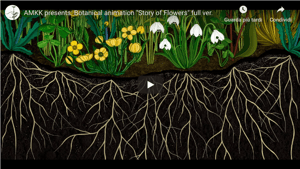How can you explain the lifecycle of flowers to a three-year old girl and make her understand that the cycle is continuous and never-ending? Azuma Makoto, one of the greatest floral artists in the world, asked himself this exact question, when confronted with the simple but challenging questions of his daughter. The answer he gave her is shown in the video “Story of Flowers”: an original work of art, created together with the illustrator Katie Scott, where sensitivity and Eastern culture meet those of the West in perfect harmony.
The visual impact and the search for the interior beauty of flowers and plants – the stylistic characteristics of Makoto, from Japan – are based on perfection with the “desire to understand nature and to encode it in time”, which supports the work of the young illustrator, Katie Scott. The British artist, in an interview with National Geographic starts off with a far from trivial thought: “I learnt more scientific concepts by drawing than I did at school”. As she likes to recall, all her work is inspired by a method that combines the most careful observation with the beauty of drawing. And in presenting “Animalium”, a rich collection of illustrations on animal biodiversity on Earth, created together with the children’s author Jenny Broom, she explains that “the drawings that accompany the current text in the books are anatomically perfect but equally anonymous, whereas the illustrations of the great masters of the past are beautiful but inaccurate by current standards. Our goal was to create a tool that was scientifically correct and at the same time aesthetically pleasing”.
Makoto’s vision, on the other hand, is inspired by an absolute love for flowers and plants, which drives all his forms of artistic expression. As he himself says in an interview:
“Flowers are an entity which is already beautiful simply by blooming in a field. We humans remove them from the natural state by cutting them off. And then we bind those flowers together. It’s therefore necessary to transform it into something even more beautiful, so that the life of these flowers and plants will not be meaningless. By placing them in an extreme situation, such as outer space or a desert, I can give them a special beauty by showing them in a way that no one has ever seen them before. That form of expression is the only viable option for me”.
The “Story of Flowers” is the result of the union of these two different talents and visions: a little masterpiece of popular science that is also a good example of what an encounter between art and science can produce.

